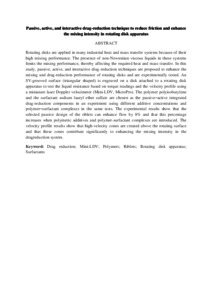Citation
A. Abdulbari, Hayder and Mohd Salleh, Mohamad Amran and Rashed, Musaab K. and Ismail, Mohd Halim Shah
(2018)
Passive, active, and interactive drag-reduction technique to reduce friction and enhance the mixing intensity in rotating disk apparatus.
Chemical Engineering Communications, 205 (12).
pp. 1-18.
ISSN 0098-6445; ESSN: 1563-5201
Abstract
Rotating disks are applied in many industrial heat and mass transfer systems because of their high mixing performance. The presence of non-Newtonian viscous liquids in these systems limits the mixing performance, thereby affecting the required heat and mass transfer. In this study, passive, active, and interactive drag-reduction techniques are proposed to enhance the mixing and drag-reduction performance of rotating disks and are experimentally tested. An SV-grooved surface (triangular shaped) is engraved on a disk attached to a rotating disk apparatus to test the liquid resistance based on torque readings and the velocity profile using a miniature laser Doppler velocimeter (Mini-LDV, MicroPro). The polymer polyisobutylene and the surfactant sodium lauryl ether sulfate are chosen as the passive–active integrated drag-reduction components in an experiment using different additive concentrations and polymer–surfactant complexes in the same tests. The experimental results show that the selected passive design of the riblets can enhance flow by 8% and that this percentage increases when polymeric additives and polymer-surfactant complexes are introduced. The velocity profile results show that high-velocity zones are created above the rotating surface and that these zones contribute significantly to enhancing the mixing intensity in the drag-reduction system.
Download File
![[img]](http://psasir.upm.edu.my/75207/1.hassmallThumbnailVersion/Passive%2C%20active%2C%20and%20interactive%20drag-reduction%20technique%20to%20reduce%20friction%20and%20enhance%20the%20mixing%20intensity%20in%20rotating%20disk%20apparatus%20.pdf)  Preview |
|
Text
Passive, active, and interactive drag-reduction technique to reduce friction and enhance the mixing intensity in rotating disk apparatus .pdf
Download (149kB)
| Preview
|
|
Additional Metadata
Actions (login required)
 |
View Item |

